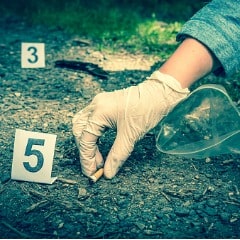 Resources
Resources
At ForensicsColleges, we want to connect students, prospective students, and professionals to the multitude of resources available online in order to stay up-to-date on recent news and trends within the online forensics community. From national news in the industry, cold cases in kidnapping, and top websites for different areas of forensic study, you can always find what you’re looking for here in our resources section.
Further your forensic knowledge and help continue the advancement of forensic research today. For additional information and up-to-date news, follow us on Twitter at @ForensicsEd.

There are various online master's programs available in criminal justice which do not require GRE scores for admission. The Graduate Record Examination is a computerized test that many graduate schools in the US require students to take. The aim of the exam is to measure students' verbal, critical thinking, and writing skills.

How Long Does it Take to Earn a Master’s in Criminal Justice?
If you have an undergraduate degree in criminology, psychology, sociology, or history under your belt and you’re exploring your options for higher education, you might consider pursuing a master’s degree in criminal justice. While many people today are interested in careers preventing crime, thanks to the many TV dramas and surging popularity of true crime podcasts, there is still plenty of room for entrants into this fascinating field.

Forensic psychology focuses on the intersection of the justice system and the understanding of the mind. While there is a large interest in careers within this arena of the psych community, some are deterred from pursuing it as a career because of what it takes to gain the required master’s degree in forensic psychology.

Forensics Casefile: Cracking the Silk Road
In the wake of the Silk Road case, the need for modern forensics investigators has only grown and so has the complexity of their task. This isn’t just a fight against an increasingly adept criminal class, but also one to master the modes and methods of the bleeding edge of technology.

The field of nuclear forensics requires extensive scientific knowledge, including familiarity with various nuclear and radiation processes, as well as some degree of investigative skill. Duties might require going into the field to measure isotopes, searching for other traces, and then spending time in the lab analyzing information and comparing data to other known nuclear signatures.

Body Farms and Other Novel Tools of Forensic Education
One of the biggest debates in education is how to find a proper balance between theory and practical applications to help students master complex subjects. Focusing on theory can provide a strong foundation, while hands-on experiences provide lessons beyond what can be absorbed in books and lectures.

Painting a Mug Shot with Genetics: A Spotlight on DNA Phenotyping
Today, investigators can solve cases using computer programs to generate possible facial images of suspects or victims based on DNA.

What Can I Do with a Degree in Digital Forensics?
As cybercrimes such as state-sponsored attacks, “smart spam,” and ransomware continue to proliferate, so too will the career opportunities for people with degrees in digital forensics. Check out this guide to high-growth careers in this field.


